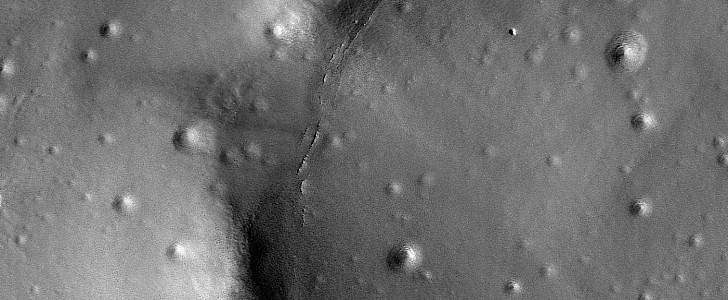Craters are very common occurrences on Mars. The planet, located right next door to the Asteroid Belt, got constantly hit by asteroids eons ago, and there are now an estimated 385,000 craters larger than 1 kilometer (0.62 miles), of which 43,000 are larger than 5 kilometers (3 miles). By comparison, we only know of 120 craters here on Earth.
Such a large number of holes in the ground means of course great diversity. And we’re not only talking in terms of size or shape, but also in terms of properties.
The now largely desert world is not as uniform under the surface as it is above. We don’t yet know its exact composition, but we do know that from place to place Mars hides ice under its reddish crust, and that makes us hopeful we’ll see even more surprises in the future.
Depending on the composition of the places asteroids hit, some craters get peculiar features. Like, say, if the impact occurs in a region with subsurface ice, craters can become shapeshifters, slowly disappearing, as if dying.
That’s because the planet’s atmosphere does not allow ice to survive in this form on the surface. Once exposed to the elements, ice sublimates, meaning it goes directly from a solid state to a gaseous one. In doing so, it alters the shape of the crater, expanding and flattening it until it becomes barely recognizable.
That’s exactly what happened to the one shown in the main photo of this piece, located in the northern lowlands of the planet. Seen through the lens of the HiRISE camera back in 2015, from an altitude of 306 km (190 miles), the crater is not unlike others in the region, but “smoother and shallower than their counterparts closer to the equator.”
Finding them can, of course, lead to a better understanding of the distribution of subsurface ice on the planet, which is extremely important for NASA’s plans to use in-situ resources for future missions.
The now largely desert world is not as uniform under the surface as it is above. We don’t yet know its exact composition, but we do know that from place to place Mars hides ice under its reddish crust, and that makes us hopeful we’ll see even more surprises in the future.
Depending on the composition of the places asteroids hit, some craters get peculiar features. Like, say, if the impact occurs in a region with subsurface ice, craters can become shapeshifters, slowly disappearing, as if dying.
That’s because the planet’s atmosphere does not allow ice to survive in this form on the surface. Once exposed to the elements, ice sublimates, meaning it goes directly from a solid state to a gaseous one. In doing so, it alters the shape of the crater, expanding and flattening it until it becomes barely recognizable.
That’s exactly what happened to the one shown in the main photo of this piece, located in the northern lowlands of the planet. Seen through the lens of the HiRISE camera back in 2015, from an altitude of 306 km (190 miles), the crater is not unlike others in the region, but “smoother and shallower than their counterparts closer to the equator.”
Finding them can, of course, lead to a better understanding of the distribution of subsurface ice on the planet, which is extremely important for NASA’s plans to use in-situ resources for future missions.






